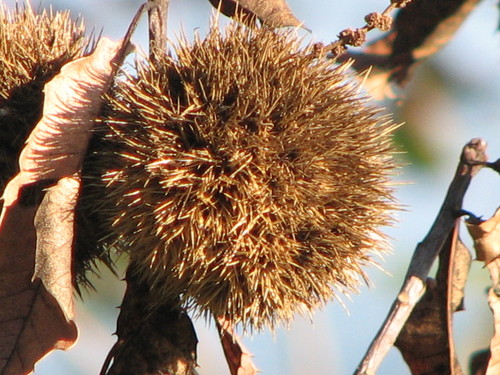Happy holidays! Did you know the tradition of roasting chestnuts nearly ended with the extinction of the American Chestnut tree?
Presently the American Chestnut tree is near extinction because of a fungus introduced from China or Japan around the turn of the century. The fungus, which became an epidemic lasting over 100 years, is a visible orange cluster that literally dissolves the wood of the chestnut. The next generation of chestnut is stunted and barren. So while technically American Chestnut trees may exist in sprouts here and there they are extremely rare to find as full trees and producing the holiday sensation, the chestnut.
Historically, the American Chestnut was extremely significant throughout Eastern North America not only for their festive seasonal snack but for their abundance and utility. The American Chestnut once occupied 1/4 of all hard wood trees in Eastern North America. As a hard wood the American Chestnut was uniquely light weight and water-resistant, ideal for railroad ties, barn beams, shingles, and home construction particularly on the sea-locked east end. Before the blight (an epidemic for trees) the Chestnut was known for being so hardy it could withstand root rot, clear cutting (the American Chestnut can re-sprout from its’ own roots) and frost. Being able to withstanding frost allowed the tree a much later flowering and harvesting season and so provided an important food source at a time of scarcity for wild animals, livestock and people. Since December is peak season for the chestnuts they were important as a late fall and wintery food source… hence the holiday association with roasting chestnuts!
Interestingly, some of the few remaining American Chestnut trees are hidden in the forests in the hamptons. I spotted one on a hike with the Southampton Trails Preservation Society and learning about the blight from some members was the impetus for this blog post. From Sag Harbour to East Quogue there are streets named Chestnut and even through the 80’s I remember picking up chestnuts on my way in & out of Penny Candy. From shingles to street names to childhood memories the American Chestnut is important to the east end.
While there is no cure for the asian fungus that has killed most of the American Chestnuts, there are blight-resistant Chestnuts begin engineered. Through years of molecular plant pathology research, breeding and collaboration a new strain of American Chestnut has been engineered resistant to the blight and might be ready for popular enjoyment soon.
In the meantime you can help by identifying any American Chestnut and submitting it to the American Chestnut Foundation’s (ACF) centralized registry or volunteering to test plant a hybrid with a local ACF chapter.


This Post Has 0 Comments